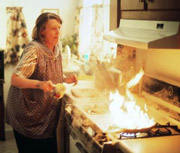How did a fictional dysfunctional Italian-American criminal family become role models for all of white-bread America? When I was growing up, Eliot Ness was the hero and Frank Nitti the Bad Guy. Now the FBI is publically disgraced, and an insecure, overweight New Jersey mobster is the guy to cheer for. And what’s the thing suddenly about Italian-American food? Have Marcella Hazan and Giuliano Bugialli, apostles of the kind of Italian cuisine that’s not all tomato sauce and pasta, lived for nothing?
Whatever the cause—Americans’ need for reassuring comfort food in uncertain political and economic times, or just the ratification of gluttony and obesity implied by items like the Sopranos’ “Sunday Gravy”—the market is flooded with Italian cookbooks this season. A lot of them are quickies run up just to cash in on a fad, but some deserve more attention. Here are a few you might want to consider, for your own culinary library or a friend’s.
The Sopranos Family Cookbook (Warner Books, $29.95): A huge best seller, this could have been straight cheap exploitation, but in fact it’s a good cookbook, jokey photos and coy “first-person” essays from series characters notwithstanding. The target audience, naturally, is what I might call the meat-and-tomatoes crowd, for whom the term “Italian cuisine” calls up images of Clemenza making meatballs and sauce while the Corleone family hunkers down for a gang war.
I admit I expected the worst, but after you get through the introductions to each chapter by a different character from the phenomenally popular HBO series, the recipes are surprisingly good. Yes, even the one for “Sunday Gravy,” which looks like a cholesterol sundae. But beware—the mere sight of this cookbook causes otherwise sensible folk to swagger around calling for “manicot'” in a bad Italian accent.
Italian Classics (Boston Common Press, $29.95): Clemenza would never be found in Cook’s Illustrated‘s prim Boston test kitchen, but this book—like all of Cook’s Illustrated‘s exhaustively researched books—is an essential reference tool for serious cooks. So what if New England Puritans aren’t the first people you’d ask to teach you to make lasagna? The CI test-kitchen folks make sure you understand not just the what but the why of each ingredient and procedure. Even if you use a recipe from another cookbook, read the Cook’s Illustrated version before you begin.
Rustico: Regional Italian Country Cooking (Clarkson Potter, $35): Cookbooks organized by region—as opposed to course—make me tired. I was ready to dismiss this wonderful little book, but one extraordinary recipe, “thirsty pizza” from Molise, made me take another look. Offering a soup-to-nuts menu from each of Italy’s 20 provinces, Rustico is an excellent introduction to the extraordinary range of Italian regional cooking.
Cooking the Roman Way: Authentic Recipes From the Home Cooks and Trattorias of Rome (HarperCollins, $34.95): I, for one, am not deeply enough into the Italian mystique to want to delve deeply into the cuisines of every last Italian region, but if you are, why not Rome? After all, Rome gave us spaghetti alla carbonara, bucatini all’amatriciana, pecorino romano cheese, and . . . oh, I don’t know—40 different ways to cook an artichoke?
Make It Italian: The Taste and Technique of Italian Home Cooking (Alfred A. Knopf, $29.95): A perfectly respectable, basic introduction to Italian cooking, although—in the midst of so many lusty competitors—it seems a bit tame. But, while not a must-have, it does have its virtues—like, for instance, the roasted butternut squash soup.
The Babbo Cookbook (Clarkson Potter, $40): Simply glorious, Mario Batali’s exhilarating, inspiring cookbook, based on dishes served in his wildly successful New York restaurant, is the best cookbook I’ve seen since Jerry Traunfeld’s The Herbfarm Cookbook. For whatever reason, I had problems with a lot of the recipes in Batali’s earlier effort Simple Italian Cooking, but the new book has combinations and flavors you’ve never imagined: charred corn fregula, pumpkin orzo, and pork tenderloin rubbed with porcini powder, brown sugar, and red pepper flakes and served with Jerusalem artichokes, cipollini, and Cinzano vinaigrette. . . . The complexity of some recipes may seem intimidating, but don’t worry, you’re in the hands of a master. E buon natale a tutti!





